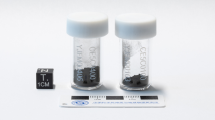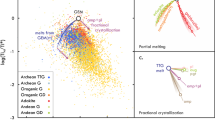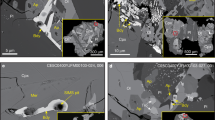Abstract
The lunar basalt samples returned by the Chang’e-5 mission erupted about 2.0 billion years ago during the late period of the Moon’s secular cooling. The conditions of mantle melting in the source region and the migration of magma through the thick lithosphere that led to this relatively late lunar volcanism remain open questions. Here we combine quantitative textural analyses of Chang’e-5 basaltic clasts, diffusion chronometry, clinopyroxene geothermobarometers and crystallization simulations to establish a holistic picture of the dynamic magmatic–thermal evolution of these young lunar basalts. We find that the Chang’e-5 basalts originated from an olivine-bearing pyroxenite mantle source (10–13 kbar or 250 ± 50 km; 1,350 ± 50 °C), similar to Apollo 12 low-Ti basalts. We propose these magmas then ascended through the plumbing system and accumulated mainly at the top of the lithospheric mantle (~2–5 kbar or 40–100 km, 1,150 ± 50 °C), where they stalled at least several hundred days and evolved via high-degree fractional crystallization. Finally, the remaining evolved melts erupted rapidly onto the surface over several days. Our magmatic–thermal evolution model indicates abundant low-solidus pyroxenites in the mantle source with a slightly enhanced inventory of radioactive elements can explain the prolonged, but declining, lunar volcanism up to about 2 billion years ago and beyond.
This is a preview of subscription content, access via your institution
Access options
Access Nature and 54 other Nature Portfolio journals
Get Nature+, our best-value online-access subscription
$29.99 / 30 days
cancel any time
Subscribe to this journal
Receive 12 print issues and online access
$259.00 per year
only $21.58 per issue
Buy this article
- Purchase on Springer Link
- Instant access to full article PDF
Prices may be subject to local taxes which are calculated during checkout





Similar content being viewed by others
Data availability
All data analysed or generated during this study are available in EarthChem Library at https://doi.org/10.26022/IEDA/112769, Science Data Bank at https://doi.org/10.57760/sciencedb.o00009.00468 and Supplementary Tables. Source data are provided with this paper.
Code availability
The MATLAB code used for diffusion modelling and error calculation in this study can be obtained from the corresponding author B.L.
References
Wilson, L. Volcanism in the Solar System. Nat. Geosci. 2, 389–397 (2009).
Head, J. W. & Wilson, L. Planetary volcanology: progress, problems, and opportunities. Bull. Volcanol. 84, 23 (2022).
Shearer, C. K. et al. Thermal and magmatic evolution of the Moon. Rev. Mineral. Geochem. 60, 365–518 (2006).
Hiesinger, H., Head, J. W., Wolf, U., Jaumann, R. & Neukum, G. Ages and stratigraphy of mare basalts in Oceanus Procellarum, Mare Nubium, Mare Cognitum, and Mare Insularum. J. Geophys. Res. E 108, 5065 (2003).
Hiesinger, H., Head, J. W., Wolf, U., Jaumann, R. & Neukum, G. in Recent Advances and Current Research Issues in Lunar Stratigraphy (eds Ambrose, W. A. & Williams, D. A.) Ch. 1 (GSA, 2011).
Merle, R. E. et al. Pb–Pb ages and initial Pb isotopic composition of lunar meteorites: NWA 773 clan, NWA 4734, and Dhofar 287. Meteorit. Planet. Sci. 55, 1808–1832 (2020).
Jolliff, B. L., Gillis, J. J., Haskin, L. A., Korotev, R. L. & Wieczorek, M. A. Major lunar crustal terranes: surface expressions and crust–mantle origins. J. Geophys. Res. Planets 105, 4197–4216 (2000).
Wieczorek, M. A. & Phillips, R. J. The ‘Procellarum KREEP Terrane’: implications for mare volcanism and lunar evolution. J. Geophys. Res. Planets 105, 20417–20430 (2000).
Borg, L., Shearer, C., Asmerom, Y. & Papike, J. Prolonged KREEP magmatism on the Moon indicated by the youngest dated lunar igneous rock. Nature 432, 209–211 (2004).
Laneuville, M., Wieczorek, M. A., Breuer, D. & Tosi, N. Asymmetric thermal evolution of the Moon. J. Geophys. Res. Planets 118, 1435–1452 (2013).
Li, Q.-L. et al. Two-billion-year-old volcanism on the Moon from Chang’e-5 basalts. Nature 600, 54–58 (2021).
Che, X. et al. Age and composition of young basalts on the Moon, measured from samples returned by Chang’e-5. Science 374, 887–890 (2021).
Tian, H.-C. et al. Non-KREEP origin for Chang’e-5 basalts in the Procellarum KREEP Terrane. Nature 600, 59–63 (2021).
Hu, S. et al. A dry lunar mantle reservoir for young mare basalts of Chang’e-5. Nature 600, 49–53 (2021).
Wilson, L. & Head, J. W. Generation, ascent and eruption of magma on the Moon: new insights into source depths, magma supply, intrusions and effusive/explosive eruptions (part 1: theory). Icarus 283, 146–175 (2017).
Head, J. W. & Wilson, L. Generation, ascent and eruption of magma on the Moon: new insights into source depths, magma supply, intrusions and effusive/explosive eruptions (part 2: predicted emplacement processes and observations). Icarus 283, 176–223 (2017).
Qian, Y., Xiao, L., Head, J. W. & Wilson, L. The long sinuous rille system in northern Oceanus Procellarum and its relation to the Chang’e-5 returned samples. Geophys. Res. Lett. 48, e2021GL092663 (2021).
Zong, K. et al. Bulk compositions of the Chang’e-5 lunar soil: insights into chemical homogeneity, exotic addition, and origin of landing site basalts. Geochim. Cosmochim. Acta 335, 284–296 (2022).
He, Q. et al. Detailed petrogenesis of the unsampled Oceanus Procellarum: the case of the Chang’e-5 mare basalts. Icarus 383, 115082 (2022).
Li, C. et al. Characteristics of the lunar samples returned by the Chang’e-5 mission. Natl Sci. Rev. https://doi.org/10.1093/nsr/nwab188 (2021).
Yang, W. et al. Geochemistry of impact glasses in the Chang’e-5 regolith: constraints on impact melting and the petrogenesis of local basalt. Geochim. Cosmochim. Acta 335, 183–196 (2022).
Zhang, D. et al. Titanium in olivine reveals low-Ti origin of the Chang’e-5 lunar basalts. Lithos 414–415, 106639 (2022).
Bence, A. E., Papik, J. J. & Lindsley, D. Crystallization histories of clinopyroxenes in two porphyritic rocks from Oceanus Procellarum. In Proc. Second Lunal Science Conference Vol. I, 559–574 (MIT Press, 1971).
Bence, A. E. & Papike, J. J. Pyroxenes as recorders of lunar basalt petrogenesis: chemical trends due to crystal–liquid interaction. Geochim. Cosmochim. Acta 3, 431–469 (1972).
Costa, F., Shea, T. & Ubide, T. Diffusion chronometry and the timescales of magmatic processes. Nat. Rev. Earth Environ. 1, 201–214 (2020).
Neave, D. A. & Putirka, K. D. A new clinopyroxene–liquid barometer, and implications for magma storage pressures under Icelandic rift zones. Am. Mineral. 102, 777–794 (2017).
Blundy, J. & Cashman, K. Petrologic reconstruction of magmatic system variables and processes. Rev. Mineral. Geochem. 69, 179–239 (2008).
Ghiorso, M. S., Hirschmann, M. M., Reiners, P. W. & Kress, V. C. III The pMELTS: a revision of MELTS for improved calculation of phase relations and major element partitioning related to partial melting of the mantle to 3 GPa. Geochem. Geophys. Geosyst. https://doi.org/10.1029/2001GC000217 (2002).
Putirka, K. D. Thermometers and barometers for volcanic systems. Rev. Mineral. Geochem. 69, 61–120 (2008).
Marsh, B. D. Crystal size distribution (CSD) in rocks and the kinetics and dynamics of crystallization. Contrib. Mineral. Petrol. 99, 277–291 (1988).
Cashman, K. V. Crystal Size distribution (CSD) analysis of volcanic samples: advances and challenges. Front. Earth Sci. 8, 291 (2020).
Webb, S. et al. Crystal size distribution of plagioclase in basalt fragments from Oceanus Procellarum recovered by Chang’e-5. in 53rd Lunar and Planetary Science Conference, 2896 (2022).
Brugger, C. R. & Hammer, J. E. Crystal size distribution analysis of plagioclase in experimentally decompressed hydrous rhyodacite magma. Earth Planet. Sci. Lett. 300, 246–254 (2010).
Neal, C. R. et al. Crystal size distribution of ilmenite in Chang’e 5 basalt clasts. in 53rd Lunar and Planetary Science Conference 2353 (2022).
Burkhard, D. J. M. Nucleation and growth rates of pyroxene, plagioclase, and Fe-Ti oxides in basalt under atmospheric conditions. Eur. J. Mineral. 17, 675–685 (2005).
Müller, T., Dohmen, R., Becker, H. W., ter Heege, J. H. & Chakraborty, S. Fe–Mg interdiffusion rates in clinopyroxene: experimental data and implications for Fe–Mg exchange geothermometers. Contrib. Mineral. Petrol. 166, 1563–1576 (2013).
Riker, J. M., Cashman, K. V., Rust, A. C. & Blundy, J. D. Experimental constraints on plagioclase crystallization during H2O- and H2O-CO2-saturated magma decompression. J. Petrol. 56, 1967–1998 (2015).
Hollister, L. S., Trzcienski, W. E.Jr., Hargraves, R. B. & Kulick, C. G. Petrogenetic significance of pyroxenes in two Apollo 12 samples. In Proc. Second Lunar Science Conference Vol. 2, 529–557 (MIT Press, 1971).
Boyd, F. & Smith, D. Compositional zoning in pyroxenes from lunar rock 12021, Oceanus Procellarum. J. Petrol. 12, 439–464 (1971).
Walker, D., Kirkpatrick, R. J., Longhi, J. & Hays, J. F. Crystallization history of lunar picritic basalt sample 12002: phase-equilibria and cooling-rate studies. GSA Bull. 87, 646–656 (1976).
Green, D. H., Ringwood, A. E., Ware, N. G., Hibberson, W. O. & Kiss, E. Experimental petrology and petrogenesis of Apollo 12 basalts. In Proc. Second Lunar Science Conference Vol. 1, 601–615 (MIT Press,1971).
Grove, T. L., Walker, D., Longhi, J., Stolper, E. & Hays, J. F. Petrology of rock 12002 and origin of picritic basalts at Oceanus Procellarum. In Proc. Fourth Lunar Science Conference (Supplement 4, Geochim. Cosmochim. Acta) Vol. 1, 995–1011 (Lunar and Planetary Institute, 1973).
Grove, T. L. & Krawczynski, M. J. Lunar mare volcanism: where did the magmas come from? Elements 5, 29–34 (2009).
Su, B. et al. Fusible mantle cumulates trigger young mare volcanism on the Cooling Moon. Sci. Adv. 8, eabn2103 (2022).
Elkins-Tanton, L. T., Hager, B. H. & Grove, T. L. Magmatic effects of the lunar late heavy bombardment. Earth Planet. Sci. Lett. 222, 17–27 (2004).
Weber, R. C., Lin, P.-Y., Garnero, E. J., Williams, Q. & Lognonné, P. Seismic detection of the lunar core. Science 331, 309–312 (2011).
Wieczorek, M. A. et al. The crust of the Moon as seen by GRAIL. Science 339, 671–675 (2013).
Elardo, S. M. et al. The origin of young mare basalts inferred from lunar meteorites Northwest Africa 4734, 032, and LaPaz Icefield 02205. Meteorit. Planet. Sci. 49, 261–291 (2014).
Snyder, G. A., Taylor, L. A. & Neal, C. R. A chemical model for generating the sources of mare basalts: Combined equilibrium and fractional crystallization of the lunar magmasphere. Geochim. Cosmochim. Acta 56, 3809–3823 (1992).
Elkins-Tanton, L. T., Burgess, S. & Yin, Q.-Z. The lunar magma ocean: reconciling the solidification process with lunar petrology and geochronology. Earth Planet. Sci. Lett. 304, 326–336 (2011).
Lin, Y., Tronche, E. J., Steenstra, E. S. & van Westrenen, W. Evidence for an early wet Moon from experimental crystallization of the lunar magma ocean. Nat. Geosci. 10, 14–18 (2017).
Warren, P. H., Haack, H. & Rasmussen, K. L. Megaregolith insulation and the duration of cooling to isotopic closure within differentiated asteroids and the Moon. J. Geophys. Res. Solid Earth 96, 5909–5923 (1991).
Cashman, K. V. & Marsh, B. D. Crystal size distribution (CSD) in rocks and the kinetics and dynamics of crystallization II: Makaopuhi lava lake. Contrib. Mineral. Petrol. 99, 292–305 (1988).
China National Space Administration. Lunar Sample Information Database (2023); https://moon.bao.ac.cn/moonSampleMode/index.html
Morgan, D. J. & Jerram, D. A. On estimating crystal shape for crystal size distribution analysis. J. Volcanol. Geotherm. Res. 154, 1–7 (2006).
Higgins, M. D. Measurement of crystal size distributions. Am. Mineral. 85, 1105–1116 (2000).
Donohue, P. H. & Neal, C. R. Quantitative textural analysis of ilmenite in Apollo 17 high-titanium mare basalts. Geochim. Cosmochim. Acta 149, 115–130 (2015).
Mollo, S., Del Gaudio, P., Ventura, G., Iezzi, G. & Scarlato, P. Dependence of clinopyroxene composition on cooling rate in basaltic magmas: implications for thermobarometry. Lithos 118, 302–312 (2010).
Putirka, K. Clinopyroxene + liquid equilibria to 100 kbar and 2450 K. Contrib. Mineral. Petrol. 135, 151–163 (1999).
Morgan, D. J. et al. Time scales of crystal residence and magma chamber volume from modelling of diffusion profiles in phenocrysts: Vesuvius 1944. Earth Planet. Sci. Lett. 222, 933–946 (2004).
Dohmen, R., Faak, K. & Blundy, J. D. Chronometry and speedometry of magmatic processes using chemical diffusion in olivine, plagioclase and pyroxenes. Rev. Mineral. Geochem. 83, 535–575 (2017).
Saunders, K., Buse, B., Kilburn, M. R., Kearns, S. & Blundy, J. Nanoscale characterisation of crystal zoning. Chem. Geol. 364, 20–32 (2014).
Zhang, Y. Geochemical Kinetics (Princeton University Press, 2009).
Costa, F. Clocks in magmatic rocks. Annu. Rev. Earth Planet. Sci. 49, 231–252 (2021).
Costa, F. & Morgan, D. in Timescales of Magmatic Processes: From Core to Atmosphere (eds Dosseto, A., Turner, P.A. & Van Orman, J.A.), Ch. 7 (John Wiley & Sons, 2010); https://doi.org/10.1002/9781444328509.ch7
Acknowledgements
We appreciate all staff of the Chang’e-5 mission, and their great effort makes this work possible. We thank China National Space Administration (CNSA) for providing access to the returned sample (CE5C0400) and China University of Geoscience, Wuhan for technical support. This work was supported by the pre-research project on Civil Aerospace Technologies funded by CNSA to Z. W. (no. D020205). B.L. thanks the China Scholarship Council (no. 201906415001) and K. Cashman, J. Blundy and A. Rust for guiding volcanology research.
Author information
Authors and Affiliations
Contributions
Z.W. applied the CE-5 samples from CNSA with the help of Q.H., X.W., K.Z., Z.H., L.X., W.Z. and Z.S., and B.L. and Z.W. designed this research. Q.H., Y.L., X.W. and J.Z. prepared the samples. B.L., B.R., J.S., B.H., Y.H., C.X., F.P. and W.L. carried out experiments. B.L. and Z.W. wrote the manuscript draft, Y.Q., J.W.H., F.M., L.X., H.B., H.Z. and L.X. revised the manuscript, and all authors participated in data interpretation.
Corresponding authors
Ethics declarations
Competing interests
The authors declare no competing interests.
Peer review
Peer review information
Nature Geoscience thanks Charles Shearer, Renaud Merle and the other, anonymous, reviewer(s) for their contribution to the peer review of this work. Primary Handling Editor: Tamara Goldin, in collaboration with the Nature Geoscience team.
Additional information
Publisher’s note Springer Nature remains neutral with regard to jurisdictional claims in published maps and institutional affiliations.
Extended data
Extended Data Fig. 1 Some reprehensive backscattered electron (BSE) images of the Chang’E-5 basalt clasts in this study were used for CSD analyzed.
a–e, Microlites in groundmass. a. LS-5-28. b. Outline of plagioclase in LS-5-28. c. LS-1-142. d. LS-2-66. e. 26-710. f. Porphyritic, CE-2. Cpx, clinopyroxene; Pl, plagioclase; Ol, olivine; Ilm, ilmenite.
Extended Data Fig. 2 Representative textural and compositional zoning diagrams for different types of clinopyroxene.
Type I-a, microlites: a, d, 5-28-1A; Type I-b, larger phenocrysts: b, e, 26-2-01; and c f, 26-1-01; Type II, patchy zoning, g-j, 24-632-C; Type III-a, normal zoning: k, n, 11-2-C; l, o, 23-01; and m, p, 21-3B. Insert circles represent the crystallographic and traverse orientation projection that were measured by EBSD. α, β and γ are angles between measured profile and [100], [010] and [001] axes, respectively. The white bars represent 10 μm.
Extended Data Fig. 3 Chemical composition of clinopyroxene from the Chang’E-5 basaltic fragments.
a, Quadrilateral diagram of clinopyroxene (Cpx). The grey dots are all the original CPX analysis points (data are from this study and references12,13,14,19). The red dots are the relatively high Mg# analysis points and were used for the calculations of clinopyroxene-liquid thermobarometers. b, Histogram showing the distribution of the Mg# values of clinopyroxene. c, Rhodes diagram for the clinopyroxene. Cpx Mg# vs. Liquid Mg#. The composition of CE-5 B112 that equilibrium with most high Mg#-Cpx was used to represent the composition of the liquid. d, Observed Cpx components vs. Predicted Cpx components. The observed Cpx components are close to the predicted Cpx components, indicating that the calculation results are reliable. CaTs: calcium Tschermak, En: enstatite, Fs: ferrosilite, Di: diopside, Hd: hedenbergite.
Extended Data Fig. 4 The relationship between greyscale and Mg# and CaO (wt. %) for clinopyroxene.
The results show that the greyscale is mainly controlled by Mg# values, rather than CaO contents.
Extended Data Fig. 5 Diffusion coefficient and temperature calculations.
a, Diffusion coefficients DFe–Mg of clinopyroxene verses temperature (°C)36. b, pMELTs simulation results of Mg# values of clinopyroxene and temperatures at P = 0.001 kbar and P = 4 kbar, respectively. The average compositions of the CE-5 basaltic fragments (CE-5A)13 were used as starting material. The result show that the Mg# values of clinopyroxene have a good relationship with the temperature. Thus, the Mg# values of clinopyroxene can be used to estimate the crystallization temperature. Since most clinopyroxene with complex zoning formed in the deep magma reservoirs, we assume that it is most likely at a peak pressure of 4 kbar.
Extended Data Fig. 6 pMELTs simulation results.
a, Experimental phase diagram for the Apollo-12 nearly primary low-Ti basaltic sample 1200240. b–d, The phase diagrams were simulated by pMELTs for the 12002, CE-5A, and 042GP-002, respectively. The shaded circles in a, b, c and d represent the multiple-saturation points, which could indicate the potential minimum origin depth and residual minerals43. The grey lines in b are the experimental result for 1200240. The pMELTS simulation phase diagram for 12002 is very similar to that of the experimental result40, indicating that the pMELTS results are effective. The results suggest that the CE-5 basalts were saturated with olivine and pyroxene residual at deep source. e and f, pMELTS results for clinopyroxene Al2O3 or Na2O contents vs. pressures, respectively. CE-5A is the average composition of CE-5 basaltic fragments13. 042GP-002 is a relatively primitive basaltic fragment with higher Mg# (47) value13. Cpx, clinopyroxene; Pl, plagioclase; Ol, olivine; Ilm, ilmenite; Spl, spinel.
Supplementary information
Supplementary Tables
Supplementary Tables 1–3.
Source data
Source Data Fig. 1
Statistical source data.
Source Data Fig. 3
Statistical source data.
Source Data Fig. 4
Statistical source data.
Source Data Extended Data Fig. 3
Statistical source data.
Source Data Extended Data Fig. 4
Statistical source data.
Source Data Extended Data Fig. 5
Statistical source data.
Source Data Extended Data Fig. 6
Statistical source data.
Rights and permissions
Springer Nature or its licensor (e.g. a society or other partner) holds exclusive rights to this article under a publishing agreement with the author(s) or other rightsholder(s); author self-archiving of the accepted manuscript version of this article is solely governed by the terms of such publishing agreement and applicable law.
About this article
Cite this article
Luo, B., Wang, Z., Song, J. et al. The magmatic architecture and evolution of the Chang’e-5 lunar basalts. Nat. Geosci. 16, 301–308 (2023). https://doi.org/10.1038/s41561-023-01146-x
Received:
Accepted:
Published:
Issue Date:
DOI: https://doi.org/10.1038/s41561-023-01146-x



